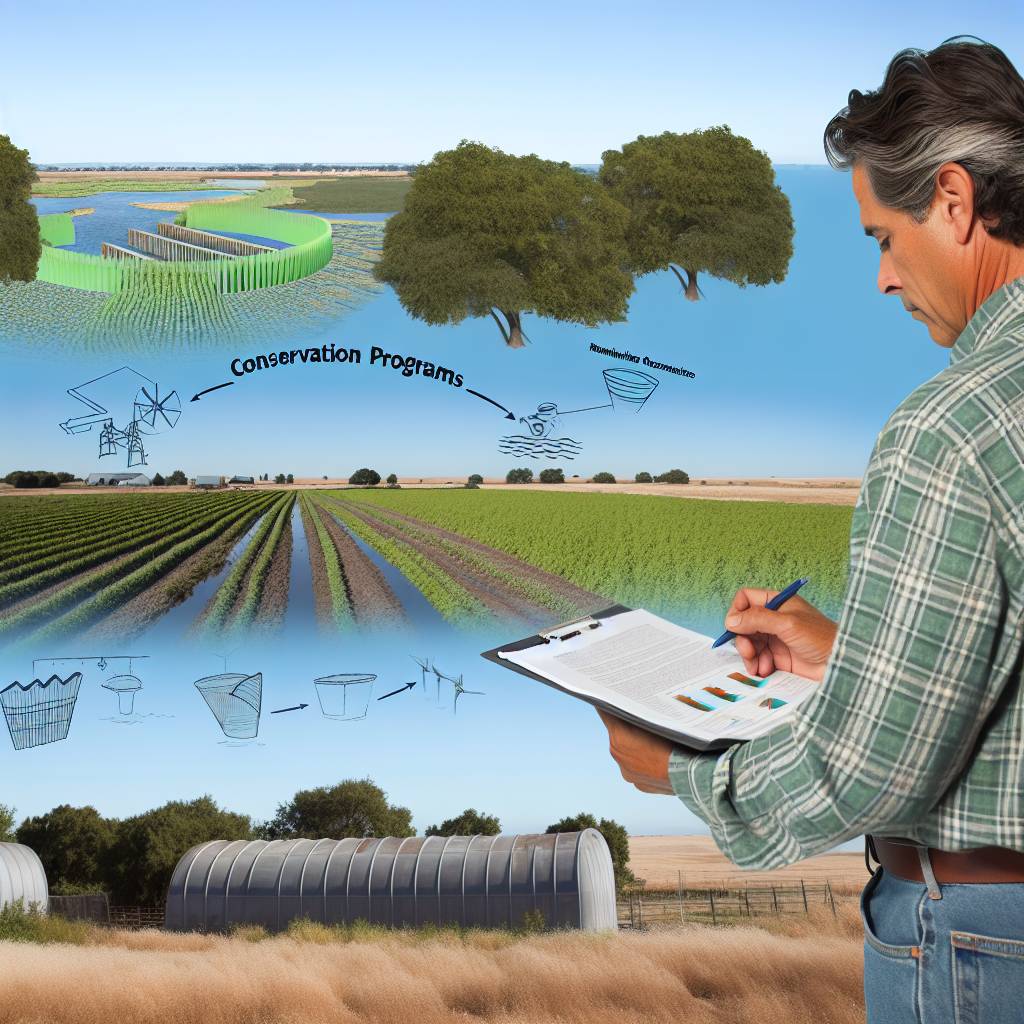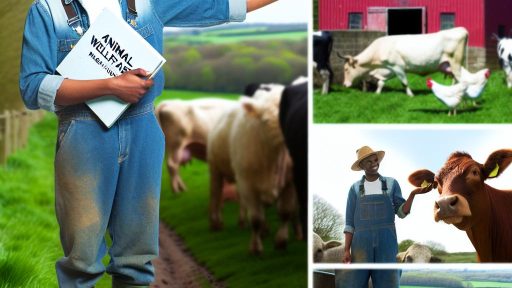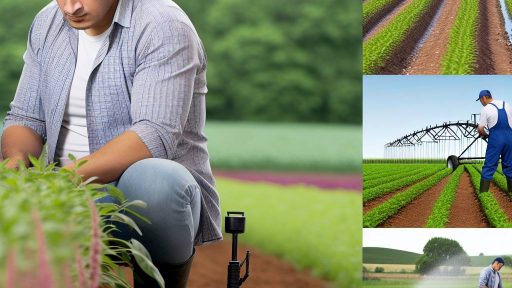Understanding Conservation Programs
Definition of Conservation Programs
Conservation programs aim to protect natural resources and biodiversity.
These initiatives involve various practices that promote ecological health.
Farmers implement conservation methods to enhance land productivity sustainably.
Additionally, they help mitigate environmental issues such as soil erosion.
Overall, these programs represent a critical approach to modern farming.
Objectives of Conservation Programs
The primary objective is to improve water quality across agricultural landscapes.
Soil conservation also plays a significant role in these efforts.
Moreover, these programs aim to enhance habitat for wildlife species.
They promote sustainable agricultural practices to ensure long-term productivity.
Additionally, these initiatives seek to engage local communities in conservation efforts.
Types of Conservation Programs
Many conservation programs fall under various categories.
For example, land retirement programs incentivize farmers to refrain from planting.
Additionally, soil health programs offer guidance on best management practices.
Water conservation initiatives develop methods to use water efficiently.
Furthermore, wildlife habitat programs encourage practices that support biodiversity.
Transform Your Agribusiness
Unlock your farm's potential with expert advice tailored to your needs. Get actionable steps that drive real results.
Get StartedKey Stakeholders in Conservation Programs
Numerous stakeholders play vital roles in conservation programs.
Farmers are the primary implementers of these practices on the ground.
Government agencies provide funding and technical assistance to support efforts.
Non-profit organizations often advocate for conservation initiatives.
Lastly, local communities benefit from healthy ecosystems through these programs.
Assessing the Environmental Impact of Current Farming Practices
Understanding Current Practices
Farm management often prioritizes productivity over sustainability.
This approach can lead to soil degradation and loss of biodiversity.
Moreover, chemical inputs frequently contaminate water sources.
Identifying Key Environmental Issues
One major issue is soil erosion caused by intensive tillage.
Additionally, monoculture practices reduce ecosystem resilience.
These practices contribute significantly to habitat loss for wildlife.
Utilizing Assessment Tools
Farmers can use tools like soil health assessments.
These assessments measure soil quality and ecosystem function.
Furthermore, water quality testing helps identify contamination levels.
Conducting Impact Assessments
Impact assessments evaluate the repercussions of farming activities.
They consider effects on local ecosystems and communities.
Regular reporting helps track changes and improve practices.
Engaging with Stakeholders
Collaboration with agricultural extension services can enhance assessments.
Farmers can receive valuable insights from local universities.
Additionally, partnerships with conservation groups can foster best practices.
Implementing Changes Based on Findings
After conducting assessments, farmers can adopt new strategies.
Crop rotation is one effective method to improve soil health.
Minimizing chemical use reduces contamination risks.
Continuous Monitoring and Feedback
Continuous monitoring ensures the effectiveness of implemented strategies.
Showcase Your Farming Business
Publish your professional farming services profile on our blog for a one-time fee of $200 and reach a dedicated audience of farmers and agribusiness owners.
Publish Your ProfileFarmers should seek feedback from community members and experts.
This iterative process leads to better adaptability over time.
Benefits of Integrating Conservation Practices into Farm Management
Enhancing Soil Health
Integrating conservation practices significantly boosts soil health.
Healthy soil supports robust plant growth and productivity.
Additionally, it enhances soil organic matter, which improves nutrient retention.
Farmers can reduce erosion and compaction by adopting no-till methods.
Furthermore, cover crops contribute to soil fertility and biodiversity.
Improving Water Quality
Conservation practices effectively manage water runoff.
This helps prevent soil erosion and nutrient leaching into waterways.
Buffer strips and wetlands filter pollutants before they reach water sources.
Consequently, farmers contribute to healthier aquatic ecosystems.
Moreover, this approach can lead to improved irrigation efficiency.
Increasing Biodiversity
Integrating conservation promotes greater biodiversity on farms.
Farmers create habitats for various species by preserving native vegetation.
Increased biodiversity leads to a more resilient ecosystem.
This resilience helps farms withstand pests and climate variability.
Moreover, diverse systems can improve pollinator health, benefiting crops.
Boosting Economic Viability
Adopting conservation practices can enhance a farm’s economic returns.
Cost savings emerge from reduced input requirements, such as fertilizers.
Moreover, sustainable practices can open access to new markets.
For instance, consumers increasingly prefer sustainably farmed products.
This shift creates additional revenue opportunities for farmers.
Complying with Regulations
Integrating conservation practices helps farms meet environmental regulations.
Sustainable practices position farmers favorably in policy discussions.
Compliance with regulations can prevent costly fines and penalties.
Ultimately, proactive management showcases environmental stewardship.
Farmers can improve their public image and community relations through these efforts.
Learn More: Implementing Buffer Zones For Chemical Applications
Types of Conservation Programs Available to Farmers
Soil Conservation Programs
Soi conservation programs aim to enhance soil health and productivity.
These programs often include practices like crop rotation and cover cropping.
Farmers can receive guidance on minimizing soil erosion.
They can also learn techniques to improve soil organic matter.
Moreover, many programs offer financial incentives for implementing these strategies.
Water Conservation Initiatives
Water conservation initiatives help farmers manage water resources more efficiently.
These initiatives may involve drip irrigation or rainwater harvesting systems.
Farmers can gain access to tools for monitoring soil moisture levels.
Additionally, educational workshops are frequently available for best practices.
Participating in these initiatives can lead to cost savings on water usage.
Biodiversity Enhancement Programs
Biodiversity enhancement programs support the restoration of habitats on farmland.
Farmers can learn about planting native vegetation to attract beneficial insects.
Showcase Your Farming Business
Publish your professional farming services profile on our blog for a one-time fee of $200 and reach a dedicated audience of farmers and agribusiness owners.
Publish Your ProfileThese programs also focus on preserving endangered species habitats.
Furthermore, farmers might gain access to funding for implementing biodiversity projects.
Enhancing biodiversity can improve ecosystem services on farms.
Integrated Pest Management (IPM) Programs
Integrated Pest Management, or IPM, offers strategies for sustainable pest control.
This approach emphasizes using natural predators and resistant crop varieties.
Farmers can reduce reliance on chemical pesticides through this method.
IPM programs often include training on pest identification and monitoring techniques.
Ultimately, these practices lead to healthier crop production.
Wildlife Habitat Programs
Wildlife habitat programs encourage farmers to create habitats for local wildlife.
These programs often provide technical assistance for setting up conservation easements.
Participating farmers can also benefit from tax incentives and grants.
Creating wildlife habitats enhances landscape diversity and ecosystem resilience.
These efforts contribute positively to the overall environment.
See Related Content: Exploring Rural Development Policies That Benefit Modern Farmers
Step-by-Step Guide to Implementing Conservation Programs on Farms
Assessing Current Farm Practices
Begin by evaluating your current farming methods.
Identify areas where conservation can be improved.
Document existing strengths and weaknesses.
Engage farm workers in this assessment process.
Setting Clear Conservation Goals
Establish specific, measurable conservation objectives.
Consider both environmental impacts and economic viability.
For instance, aim to reduce soil erosion by 30% in five years.
Involve stakeholders to ensure shared commitment.
Researching Available Programs
Explore government and nonprofit conservation programs.
Look into local initiatives that support farmers.
Gather information on funding opportunities as well.
Utilize online resources to simplify your research.
Developing a Conservation Plan
Create a comprehensive plan that outlines your strategies.
Include timelines and assigned responsibilities.
Incorporate feedback from your team in this planning phase.
Ensure your plan aligns with conservation best practices.
Training and Capacity Building
Organize training sessions for farm workers.
Focus on techniques for sustainable farming practices.
Consider partnerships with local agricultural organizations.
Facilitate ongoing education to maintain high standards.
Implementing Conservation Practices
Begin rolling out the conservation strategies outlined in your plan.
Monitor the implementation closely to address challenges.
Encourage team involvement to foster a culture of conservation.
Adjust practices as needed to optimize results.
Monitoring and Evaluating Outcomes
Regularly assess the effectiveness of implemented practices.
Use quantifiable data to track progress towards goals.
Showcase Your Farming Business
Publish your professional farming services profile on our blog for a one-time fee of $200 and reach a dedicated audience of farmers and agribusiness owners.
Publish Your ProfileCollect feedback from team members for continuous improvement.
Celebrate successes and identify areas for further development.
Reporting and Sharing Results
Create detailed reports highlighting your conservation efforts.
Share these insights with stakeholders and the community.
Use social media and local events to amplify your message.
Encourage others to adopt similar conservation practices.
Delve into the Subject: Impact of Farm-To-Table Regulations on Local Agriculture and Farmers

Case Studies: Successful Integration of Conservation Programs
Introduction to Conservation Programs
Conservation programs promote sustainable agricultural practices.
These programs help farmers enhance productivity while protecting natural resources.
By integrating these initiatives, farms can become more resilient to environmental challenges.
Case Study: Cedar Valley Farms
Cedar Valley Farms implemented a cover cropping system in 2021.
The farm focused on improving soil health through diverse crops.
This method reduced erosion significantly and increased organic matter levels.
Farmers reported higher yields in subsequent planting seasons.
Case Study: Green Pastures Cooperative
Green Pastures Cooperative adopted rotational grazing practices.
This approach enhanced pasture health and improved livestock nutrition.
Additionally, it reduced the need for chemical fertilizers.
As a result, the cooperative saw increased profitability within two years.
Case Study: Skyward Orchards
Skyward Orchards integrated pest management (IPM) techniques.
IPM emphasized the use of natural predators to control pest populations.
This reduced pesticide use and minimized chemical runoff.
Consequently, the orchard reported a healthier ecosystem and better fruit quality.
Benefits of Integration
Overall, integrating conservation programs yields numerous benefits.
- Improved soil and water quality.
- Enhanced biodiversity in farming areas.
- Long-term economic advantages for farmers.
- Strengthened community resilience to climate change.
Challenges Faced by Farmers
Farmers often face several challenges when integrating conservation programs.
Initial costs for implementation can be high and daunting.
Moreover, lack of information and guidance hampers adoption rates.
Finally, farmers may struggle to balance conservation efforts with short-term profits.
Support and Resources Available
Various organizations provide resources to assist farmers.
Government programs offer grants and subsidies to offset costs.
Additionally, local agricultural extension offices provide valuable information.
Online platforms also connect farmers with conservation specialists.
Delve into the Subject: Conservation Programs Enhancing Soil Health On Farms
Challenges and Solutions in Implementing Conservation Practices
Understanding the Common Challenges
Farmers often face significant challenges when integrating conservation practices.
One major obstacle is the initial cost of implementation.
This includes expenses for new equipment and methods.
Additionally, farmers may lack technical knowledge about conservation practices.
Some might also worry about short-term productivity losses.
Weather variability can influence decisions related to conservation efforts.
Lastly, there can be resistance to change within farming communities.
Effective Solutions for Implementation
To address these challenges, targeted education programs are essential.
Showcase Your Farming Business
Publish your professional farming services profile on our blog for a one-time fee of $200 and reach a dedicated audience of farmers and agribusiness owners.
Publish Your ProfileWorkshops can provide farmers with valuable skills and knowledge.
Offering financial incentives can help reduce initial implementation costs.
Furthermore, mentorship programs can connect experienced farmers with beginners.
Demonstration farms can showcase the benefits of conservation practices.
Local agricultural agencies should support farmers through tailored advice.
Building a Supportive Community
Creating a network can enhance the success of conservation initiatives.
Farmers can share insights and strategies for overcoming common obstacles.
Community-supported agriculture can promote local conservation efforts.
Utilizing Technology
Adopting new technologies can streamline conservation practices.
Precision agriculture tools can optimize resource use and reduce waste.
Online platforms can facilitate information sharing among farmers.
These tools can also offer data-driven support for conservation strategies.
Monitoring and Assessing Progress
Regular monitoring can identify the effectiveness of conservation practices.
Farmers should track changes in crop yield and soil health over time.
Collecting data helps in understanding what works and what needs adjustment.
Involving local universities or research institutions can provide additional insights.
Creating feedback mechanisms will help improve future conservation efforts.
Future Trends in Conservation in Agriculture and Farm Management
Emerging Technologies
Technology continues to revolutionize conservation efforts in agriculture.
Precision farming tools enable farmers to use resources more efficiently.
These innovations include soil sensors and drone technology.
Additionally, automation can reduce labor costs while enhancing productivity.
Farmers can track their environmental impact through real-time data analysis.
Regenerative Practices
Regenerative agriculture is gaining traction among progressive farmers.
This approach emphasizes restoring soil health and biodiversity.
Increasingly, farmers integrate cover cropping and reduced tillage methods.
Such practices improve soil structure and capture carbon effectively.
As a result, regenerative practices contribute to greater resilience against climate change.
Policy Development
Government policies are evolving to support conservation programs.
As a result, new incentives are emerging for sustainable farm practices.
For instance, subsidies for farmers who adopt conservation tillage grow in popularity.
Additionally, climate-smart agriculture initiatives receive more funding.
Such changes provide farmers with necessary resources and support.
Collaboration and Community Engagement
Farmers are increasingly collaborating with environmental organizations.
This trend fosters knowledge sharing and communal support.
Through partnerships, they learn about best practices in conservation.
Furthermore, community engagement initiatives amplify awareness and education.
Such efforts build a collective movement toward sustainable agriculture.
Market Demand for Sustainable Products
Consumer demand for sustainable and ethical products is rising.
This shift encourages farmers to adopt conservation methods.
Furthermore, certifications in sustainable practices boost marketability.
Showcase Your Farming Business
Publish your professional farming services profile on our blog for a one-time fee of $200 and reach a dedicated audience of farmers and agribusiness owners.
Publish Your ProfileAs consumers prioritize eco-friendly practices, farmers adapt to meet expectations.
Thus, market trends can drive significant changes in farm management strategies.




